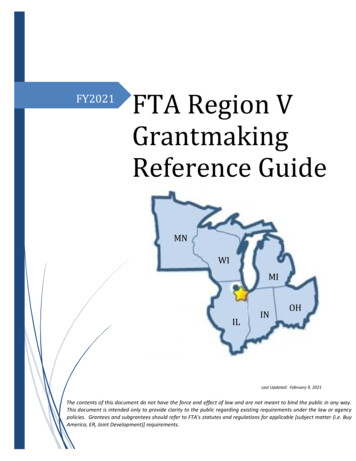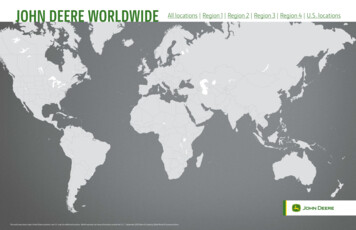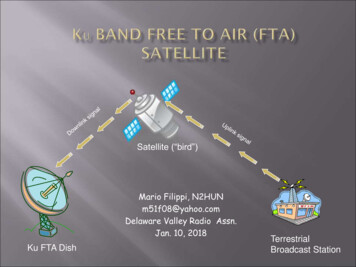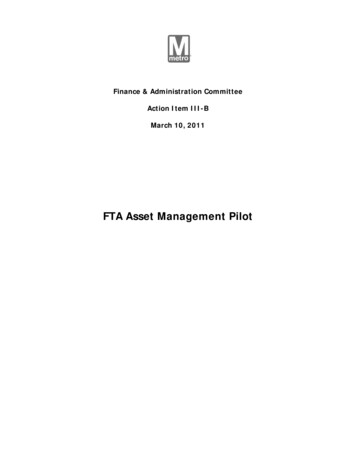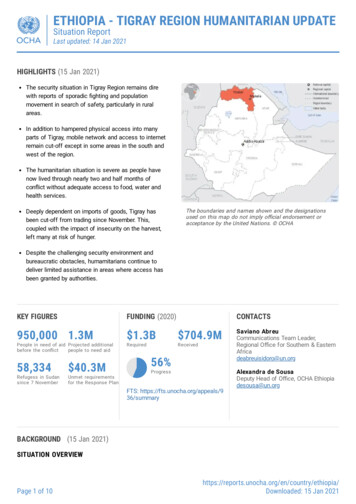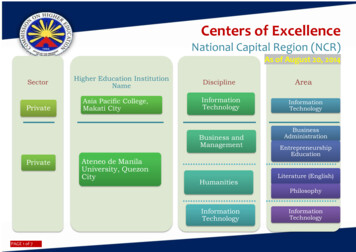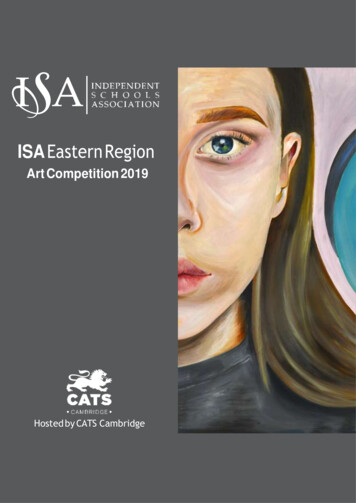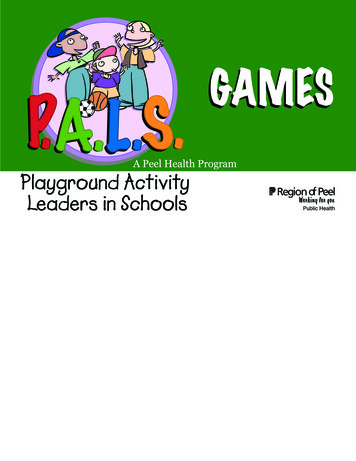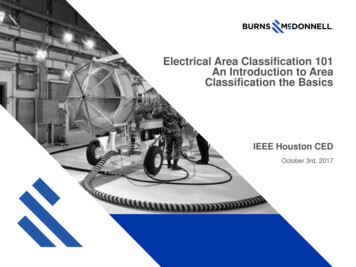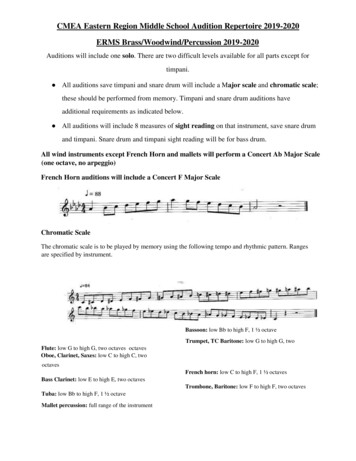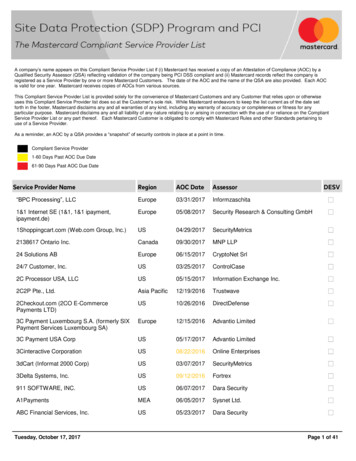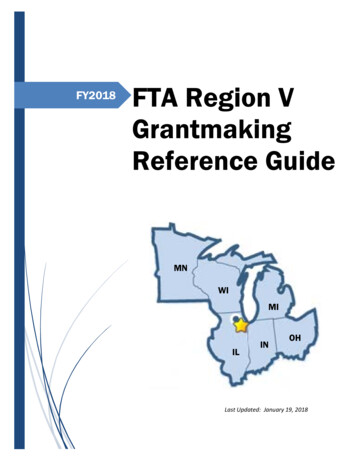
Transcription
FY2018FTA Region VGrantmakingReference GuideMNWIMIILINOHLast Updated: January 19, 2018
Table of ContentsOVERVIEW1NEW GRANT VS. GRANT AMENDMENT1“SUPER” GRANTS1GRANT STRUCTURE – FUNDING SOURCES2GRANT STRUCTURE – PROJECTS2TITLING YOUR GRANT APPLICATION3EXECUTIVE SUMMARY (ES)3PROJECTS5BUDGET ACTIVITY LINE ITEM EXTENDED BUDGET DESCRIPTIONS (EBD)7BUDGET ACTIVITY LINE ITEM MILESTONES8ENVIRONMENTAL FINDINGS (EF)8ATTACHMENTS9SECTION 5310 ENHANCED MOBILITY OF SENIORS AND INDIVIDUALS WITHDISABILITIES PROGRAM13SECTION 5311 RURAL AREA FORMULA PROGRAM16SECTION 5329 STATE SAFETY OVERSIGHT PROGRAM (SSOP)18SECTION 5337 STATE OF GOOD REPAIR PROGRAM20SECTION 5339 – BUS AND BUS FACILITY FORMULA PROGRAM21
APPENDIX 1: SAMPLE EXTENDED BUDGET DESCRIPTIONS FOR COMMON ALIS 22APPENDIX 2: COMMON ACRONYMS24
OverviewThis document serves as a reference guide to grantmaking in the Federal Transit Administration’s (FTA)Transit Award Management System (TrAMS). Grantees are strongly encouraged to contact their assignedFTA Region V Grant Representative prior to creating a new TrAMS grant application. The current FTARegion V Staff Organization Chart is accessible here.You should reference the following tools for more detailed information related to FTA’s programs, andTrAMS: FTA’s annual Apportionments, Allocations, and Program Information Federal Register onments. FTA Program circulars for information about FTA’s grant nd-guidance/fta-circulars/fta-circulars. Guidance and training tools on TrAMS can be found ams.New Grant vs. Grant AmendmentBefore entering a grant in TrAMS, it is important to have a discussion with your Grant Representative sothat you can both agree on the best approach; either creating a new grant or amending an existing grant.Keep in mind the following when creating a grant amendment: TrAMS does not allow you to add new funding programs. For example, if the original grant onlycontained Section 5307 funds, you cannot amend the grant to add Section 5339 funds. No more than three fiscal years of funding can be contained in a grant and correspondingamendments. For example, if you apply for an annual operating assistance grant (that containsfull year apportionments), you can only amend the original grant twice. Amendments must be treated as if you are creating a new grant. A new Executive Summary,Project Description, and Extended Budget Description, etc. is required. The sections belowprovide samples for how to handle amendment language.“Super” GrantsTrAMS allows grantees to combine funding from different FTA programs into a single grant. This is adeparture from how our previous grant award system, the Transportation Electronic Award ManagementSystem (TEAM) functioned. If you plan on creating a grant with multiple funding sources, also known asa “Super” Grant, please consult with your Grant Representative on how to best setup the grant.Super Grants should be used if any of the following conditions apply: Multiple funding programs are being used to fund related activities such as a capital improvementproject, a construction project or system-wide improvement project. Multiple funding programs are being used for the same budget scope and activity line item. Transferring funds from the Federal Highway Administration (FHWA) (i.e., Surface TransportationBlock Grant (STBG) and/or the Congestion Mitigation and Air Quality (CMAQ) Programs) for thesame or related projects which also use FTA program funds. An applicant is applying for funding apportioned under different formula programs (such asSection 5307, 5337, and 5339) within the same urbanized area(s).FTA Region V FY2018 Grantmaking Reference GuidePage 1
Super Grants may not be optimal if the following conditions are present: Timeline/Period of Performance for different projects are not efficiently synchronized. An application contains funding programs with different requirements e.g., DOL review orReporting Frequency, etc.When developing a Super Grant, different funding sources can be incorporated into the same project, butnot into the same scope.Grant Structure – Funding SourcesEach grant program has a unique account classification code (ACC) that is used to reserve funds. In manyinstances, a grant program (such as 5310, 5311, and 5339) has multiple ACC codes. This is important tonote when setting up your budget in TrAMS because only one ACC type can be used under each scopecode. But you can combine different fiscal years of funding under the same scope.For example, the 5310 program has multiple ACC codes (one each for funds designated to the rural, smallurban, and larger urban programs). If your grant will include funding for rural and small urban areas, thenyou will be required to use separate scopes for the rural and small urban funds. In many instances, youwill have to create an additional project in TrAMS to ensure that rural and small urban funds are notincluded in the same scope.Financial purpose codes (FPC) are assigned to each funding type. There can only be one FPC type perscope. For example, an operating assistance Activity Line Item (ALI) (FPC 04) and a capital activity ALI (FPC00) cannot be under the same scope. There are a couple of exceptions to this rule (mainly involving the5311 Program) that will be noted in this document. The following are the FPC codes for the following typeof projects:FPCDescription00Capital01Research & Training02Planning03Job Access and Reverse Commute (JARC)/New Freedom and Resiliency/Emergency04Operating Assistance06State & Program Administration07RTAP08ADA Paratransit09Multiple TypesGrant Structure – ProjectsTrAMS allows for grant activities to be grouped by Projects, which is a departure from how TEAMfunctioned. Some grants may only contain one Project while other grants contain several Projects. Grantswith multiple Projects are often separated by funding sources or by function (operating assistance,planning, vehicle purchase, facility renovation, etc.). Even if your grant only has one source of funding,there may be times when it makes sense to have multiple projects in the grant as opposed to placing allFTA Region V FY2018 Grantmaking Reference GuidePage 2
activity line items under a single project. Again, it is important to have a discussion with your GrantRepresentative so that you can both agree on the best approach.Titling Your Grant ApplicationWhen titling your grant application please note the following: The Application/Award Name will exist throughout the life of the Award and cannot be editedonce the grant has been awarded, even when amending. The Application/Award Name should be something searchable. The Application/Award Name should reflect the Scope of Work to be completed and somethingthe public can understand. The Application/Award Name should include the Section number(s) of funding (Section 5307,5309, etc.). The Application/Award Name is published in USAspending.gov.Executive Summary (ES)The Executive Summary (ES) should provide a high-level explanation of the type of projects that you areapplying for. The ES should include the following information: Total amount of Federal fiscal year of the funding that will be used. The type of funds that will be used (Section 5307, 5311, 5339, etc.). The projects/activities that are included in the grant application (purchasing replacement buses,operating assistance, preventive maintenance, renovation of a bus garage, etc.). The source of local funds. The supporting documents that are attached in the grant application (STIP approval letter, STIPproject listings, etc).Sample #1This grant provides 1,000,000 of FY 2017 Section 5307 operating assistance to the City of Oshkosh'stransit system (GO Transit) for the period of January 1, 2017 – December 31, 2017. The local share foroperating will be 500,000 provided through local tax levies (city and county), and 500,000 from theState of Wisconsin. Attachments to this application include the TIP Table referencing 2017 operatingexpenses, DOL Information, FTA STIP Approval Letter dated 1/20/17, and FY 2017 Wisconsin State5307 Allocation Letter.Sample #2This application requests funding for multiple projects, including bus purchases, design/engineeringand construction for garage projects, Communication system enhancements, Rail vehicle overhaul,fare collection upgrade, track and rail facilities, capital cost of contracting, and facility energyconservation and enhancement. This grant application is for a total of 83,322,313, with 68,217,994federal and 15,104,319 local match. The Federal funds are from the following programs:o Section 5307 funds in the amount of 2,511,512 is FFY 2016; 37,762,967 is FFY 2017.o Discretionary 5339 funds of 103,515 is FFY 2016.o Section 5337 (Bus) funds in the amount of 2,383,413 is FFY 2016; 3,776,587 is FFY 2017.o Section 5337 (Rail) funds in the amount of is 6,301,560 is FFY 2016; 4,978,440 is FFY 2017.FTA Region V FY2018 Grantmaking Reference GuidePage 3
Section 5339 funds in the amount of 1,631,911 is FFY 2015; 4,579,942 is FFY 2016; and 4,188,147 is FFY 2017.Of the local match, all is funding from Regional Transit Capital except for 750,000 of Motor VehicleSales Tax for Capital Cost of Contracting. Documents attached include the FTA/FHWA STIP approvalletter of 10/20/16, relevant STIP pages for the various projects, our Federal Indirect Rates letter, andproject descriptions and NEPA documents as appropriate for larger projects.oTrAMS will keep the information for the original grant, and previous amendments. DO NOT deletethe information carried over from the grant/grant amendment. Be sure that the descriptions for theamendment are included above the descriptions of the previous grant/amendment.Grant Amendment SampleAmendment 1: This grant provides 2,000,000 of FY 2018 Section 5307 operating assistance to theCity of Oshkosh's transit system (GO Transit) for the period of January 1, 2018 – December 31, 2018.The local share for operating will be 1,000,000 provided through local tax levies (city and county),and 1,000,000 from the State of Wisconsin. Attachments to this application include the TIP Tablereferencing 2018 operating expenses, DOL Information, FTA STIP Approval Letter dated 1/20/18, andFY 2018 Wisconsin State 5307 Allocation Letter.Original Grant: This grant provides 1,000,000 of FY 2017 Section 5307 operating assistance to theCity of Oshkosh's transit system (GO Transit) for the period of January 1, 2017 – December 31, 2017.The local share for operating will be 500,000 provided through local tax levies (city and county), and 500,000 from the State of Wisconsin. Attachments to this application include the TIP Tablereferencing 2017 operating expenses, DOL Information, FTA STIP Approval Letter dated 1/20/17, andFY 2017 Wisconsin State 5307 Allocation Letter.After entering the ES, TrAMS requires information related to the period of performance, fundingallocations, and direct/indirect cost information. TrAMS will prompt you with questions related to thesetopic areas as you develop your grant. Please note the following: Research and Development - You must answer one of the following responses; 1) “Yes, thisapplication includes funds for research and/or development activities”; or 2) “No, this applicationdoes NOT include funds for research and/or development activities.” Period of Performance (Start/End Dates) - The Start Date will always be the date of grant award.TrAMS requires you to enter an End Date. The End Date is the date by which the activities in thegrant application will be complete. This must be later than the last milestone within theapplication. Note the end date does not equal closeout date. It is important to set the End Dateto an appropriate amount of time after the last milestone date in the grant, to allow for potentialproject delays, etc. This is an important date as the End Date represents the last day in which FTAfunds can be expended. An FTA action (budget revision, or grant amendment) will be required toextend the period of performance after grant award. Pre-award Authority – Check “yes” or “no” to whether the grant will utilize pre-award authority.FTA Region V FY2018 Grantmaking Reference GuidePage 4
Suballocation Funds - If your application includes sub-allocated funds please indicate if you are aDirect Recipient or a Designated Recipient. 1 TrAMS requires you to upload the appropriatesuballocation letter(s) if you are a direct recipient of suballocated funds.Indirect Cost Rate - TrAMS will direct you to choose whether indirect costs will be used in thegrant application. Include one of the following statements if Indirect Costs WILL be applied; 1)“The cognizant agency [enter agency name] approved [enters applicant’s name on [date] and acopy of the organization’s approved rate is on file with FTA (in the EAMS). The approved rate(s)of [provide percentage(s)] will be applied to the applicable activity line descriptions”; or 2)“[Applicant’s Name] has submitted FTA’s certification and elected to use the de minimis indirectcost rate of 10 %; the agency certification and FTA’s response noting acceptance of the electionof this rate is attached in the recipient profile in the EAMS.”Delinquent federal Debt – Check “yes” or “no”. TrAMS requires you to provide details if youcheck “yes”.State E.O. 12372 Review - Check “yes” or “no”. TrAMS requires you to provide a StateApplication ID and date submitted for State review if you check “yes”.ProjectsYour Project Title should include the following information: Federal fiscal year of the funding that will be used. The type of funds that will be used (Section 5307, 5311, 5339, etc.). A description of the major activities within the project. Project Title Sample – “FY2018 Section 5307 Vehicles, Facility Rehabilitation and MiscellaneousEquipment.”The Project Description (PD) section should include a high-level summary of the project activities withfurther details on each of the Activity Line Items included in their respective Extended BudgetDescriptions. Project Description (PD) Sample- “Funding is to support the acquisition of both replacement andexpansion vehicles, reconstruction of the Downtown Transit Terminal, acquisition/installation ofsecurity cameras and fareboxes for the buses, and a vehicle wheel alignment apparatus.”The Project Benefits section should include specific details on the purpose, need and qualitative andquantitative benefits of the underlying projects to the public. For example, the project might meet stateof good repair goals, replace vehicles that have met their useful life, or expand service and offer greateropportunity for riders to reach new jobs, schools, etc. or otherwise improve the rider experience. Thenarrative should be meaningful to the public. If the grant contains CMAQ funds, the details should brieflyexplain how the project benefits air quality in the region.1A Designated Recipient is: (i) an entity designated, in accordance with the planning process under Sections 5303and 5304, by the governor of a state, responsible local officials, and publicly owned operators of publictransportation, to receive and apportion amounts under Section 5336 to urbanized areas of 200,000 or more inpopulation; or (ii) a state or regional authority, if the authority is responsible under the laws of a state for a capitalproject and for financing and directly providing public transportation. A Direct Recipient is an eligible entityauthorized by a designated recipient or state to receive Urbanized Area Formula Program funds directly from FTA.FTA Region V FY2018 Grantmaking Reference GuidePage 5
The Additional Information section should include clarifying high-level information such as other FTA grantnumbers that are supporting the same projects. For projects that include vehicles, please include thefollowing two statements: “In executing this grant, the [Name of Agency] agrees to abide by Section 3011 of the FAST Act (49U.S.C. 5323(j)(2)(C) regarding the phased increase in domestic content under the Buy Americastatute for rolling stock.” “As Grant Agreement includes an FTA-funded transit vehicle purchase, Recipient agrees to complywith the related requirements set forth in 49 CFR § 26.49(a). Specifically, Recipient must ensure asa condition of being authorized to bid or propose on FTA-assisted transit vehicle procurements,that each transit vehicle manufacturer certified that it complied with DOT requirements forsubmitting a DBE program and goal to FTA prior to bidding. Recipient is also required to submitthe name of the successful bidder and the total dollar value of the contract within 30 days ofmaking a FTA- assisted transit vehicle award using the required FTA reporting tool. Recipientunderstands that failure to comply with these requirements may result in formal enforcementaction or appropriate sanction as determined by FTA, including reimbursement of FTA funds usedfor the vehicle procurement.”The Project Location section will prompt for the appropriate Urbanized Area (UZA), CongressionalDistricts, and a Location Narrative. The Location Narrative should describe the general location of theprojects and addresses as appropriate.The Project Plan section will prompt for planning information relevant to the project. Please includedetails about the uploaded (Statewide Transportation Improvement Program (STIP) document (e.g., pagenumber where the project is mentioned in the document), similar details about the Unified Planning WorkProgram (UPWP) document (if appropriate), and a reference to the Long-Range Transportation Plan anddates of adoption.Budget Activity Line Item (ALI)A Project Budget is made up of scopes and ALIs. A Scope Code is a five digit number with anassociated general category description that will be funded (for example 111-00 – Bus Rolling Stock).Each scope has associated ALIs. FTA funds are reserved at the Scope code level. FTA fundingprograms may have different requirements for scope codes (for example all Tribal Transit Programproject line items must use scope code 600-00). When developing an application, please discuss themost appropriate Scope Codes for a project with your Grant Representative.The ALI is a six-digit number and an associated title that describes a specific activity to be funded(such as 11.12.04 – Buy Replacement 30 FT Bus). When developing the budget in TrAMS, each ALIhas an associated Scope Code, Line Item Number, quantity, total cost, FTA fund source and amount,Extended Budget Description, and a set of Milestones.Line Item numbers are three sets of two digit numbers used to narrow and categorize possibleproject work items. The first set of the Line Item number is defined at the scope code level. Forexample, #11 is used for Bus Rolling Stock capital items. The second set of numbers is defined as anActivity Type. For example, 11.12 is used for Bus Rolling Stock procurements that are replacements(typically to replace vehicles that have reached their useful life). The third and last set of numbersis the specific item description. In this example #11.12.02 would define a bus rolling stock capitalFTA Region V FY2018 Grantmaking Reference GuidePage 6
item to procure replacement buses of the type: “Bus STD 35 FT”. When developing an application,please discuss the appropriate Line Item number with your Grant Representative. The Scope ALITree is located at codes-activity-line-items.Budget Activity Line Item Extended Budget Descriptions (EBD)The ALI Extended Budget Description (EBD) should include the following information: A generously detailed description of the project. FTA should have a very clear understandingabout the project
Jan 19, 2018 · City of Oshkosh's transit system (GO Transit) for the period of January 1, 2018 December 31, 2018. – The local share for operating will be 1,000,000 provided through local tax levies (city and county), and 1,0
